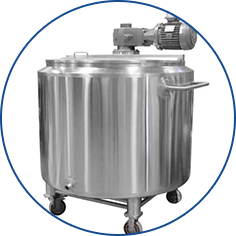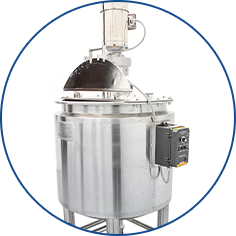Mixing Tanks for the Chemical Industry
Posted on May 15, 2023 by Cedarstone Industry Team
Mixing tanks are usually associated with brewing or food processing industries. However, they have many more uses. For instance, the beauty and chemical sectors also utilize them to mix liquid components. In this article, we will focus on mixing tanks for chemical industry – why are they used and what are their pros and cons. If you are interested – read on.
What are mixing tanks?
Mixing tanks are vessels used for combining components – both liquid and solid. They are present in a range of industries. While most commonly associated with creating drinks, mixing tanks are also used for chemical industry, beauty industry, food processing industry or even pharmaceutical industry. They are essential equipment for almost all business where you need to mix several substances together.
Mixing tanks may be made from a range of different materials. It is possible to come across their plastic versions, as well as those made of stainless steel. This is especially important for the industries that deal with chemical elements and chemical compounds. Different materials might react with some substances, therefore mixing tanks should be made of chemically neutral components. The availability of different types of these vessels, allows these industries to select the ones that are most suitable for their products.

The advantages of mixing tanks for the chemical industry
The chemical industry can benefit a lot from using these vessels. The right mixing tank makes a difference – it can improve the quality of your products while accelerating the production process. The main advantages are:
- Quicker mixing process – High-quality mixing tanks mean better temperature control and more efficient physical mixing. As a result, the whole process is faster. Additionally, mixing vessels come in different size and shapes, so it is possible to adjust their capacity to your needs. After all, mixing small quantities in a large tank would not be effective, while mixing larger amounts in smaller tanks, usually by portioning and doing it several times, would also be a waste of time.
- Larger capacity – It is impossible to mix large quantities efficiently in conventional methods. Standard laboratory procedures would let you produce only insignificant amounts of your products. However, by using mixing tanks, it is possible to process large volumes of chemicals at once. Therefore, meeting the demand is fairly easy with these vessels.
- Reliability – If you are using mixing tanks for your chemical industry business, you have a guarantee of reliability. Usual glass laboratory equipment might break easily and will probably serve for a shorter period of time than the mixing tanks.
- Ease to handle non-liquids – While mixing liquids is fairly easy, combining them with solid substances might be a bit more tricky. You would need to prepare the latter before adding it to the former. Yet, mixing tanks are capable of doing this all at once. Therefore, you might cut down on your workforce and reap the harvest of an effective mixing process of both liquids and solids.
- Foolproof cleaning process – Manual cleaning of vessels would be exhausting and difficult – even small amounts of compounds can react with what you are mixing next, thus producing a different substance, or a product with undesirable properties. However, using mixing tanks allows you to implement advanced cleaning techniques. All you need to do is choose the right type of clean-in-place system, and you can reduce the possibility of contamination to minimum.

The disadvantages of mixing tanks for the chemical industry
While mixing tanks are generally useful for the chemical industry, they also come with some downsides that you should be aware of. You should especially focus on:
- The tank’s material – Stainless steel will react with some chemical compounds, while plastic will react with different ones. This means that it is crucial to select the right mixing type tank for the kind of substances that will be combined. The same story is with the storage tanks – and these will be necessary if you produce larger quantities of your product. Unfortunately, this also means that you might need to have several kinds of mixing tanks in one facility.
- The tank’s size – While large tanks can mix more components, their maintenance cost is higher. Additionally, you also need enough free space to install them. Therefore, mixing tanks might not be an option if you produce on a small scale – the expenses might be too high.
The takeaway
Mixing tanks are a must-have for large-scale chemical industry companies. By using them, it is possible to produce bigger quantities, mix liquids with solids and avoid possible product contamination. So, if you are planning to expand your chemical production, mixing vessels are the right choice.
You might also like: Stainless Steel vs. Plastic Storage Tanks.
